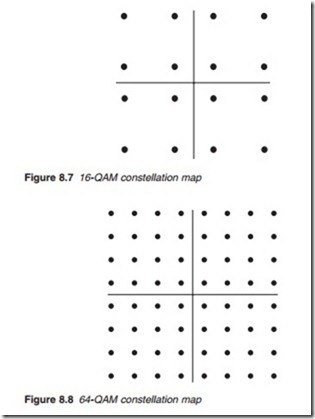Quadrature amplitude modulation
QAM is an extension of PSK in that some phasors are changed in amplitude as well as phase to provide increased bit representation. For instance, 16-QAM encoding increases the bit width of the modulation to 4 as shown in Figure 8.6. Twelve different carrier phasors are used, four of which have two amplitudes to provide further 4-bit combinations. Figure 8.7 depicts all possible carrier phase angles and amplitudes; it is known as a constel- lation map.
A higher order of digital modulation may be employed, for example, in cable, namely 64-QAM encoding, in which each carrier phase/amplitude represents one of 64 possible 6-bit combinations. The constellation map for 64-QAM is shown in Figure 8.8.
Related posts:
MPEG encoding:Coding of DCT coefficients
SURROUND-SOUND AND HOME CINEMA:DOLBY SURROUND CONCEPT.
MPEG-2 transport stream:Transport stream packet
VIDEO DISC TECHNOLOGY:SPEED-CORRECTION SERVOS.
DVD:Power supply requirements and Content protection.
MPEG-2 transport stream:Transport stream multiplexing and MPEG-2 PES packet
TV sound, mono and NICAM:TV FM mono system
REFERENCE DATA:ELECTRICAL RELATIONSHIPS.
AUDIO RECORD AND PLAYBACK:AUDIO-ONLY RECORDING ON VIDEOTAPE.
Audio encoding:Principles of MPEG-1 audio
Video re-production:Extra high tension
TV AND VIDEO WAVEFORMS AND STANDARDS:DIGITAL TV TRANSMISSION,TERRESTRIAL DIGITAL TV,TV SOUND TRANSMI...
MPEG encoding:Zigzag scanning of the DCT matrix
TV SIGNAL PROCESSING:BRIGHTNESS, CONTRAST AND COLOUR CONTROL.
VIDEORECORDER DECK CONTROL:SYSCON OUTPUTS.
